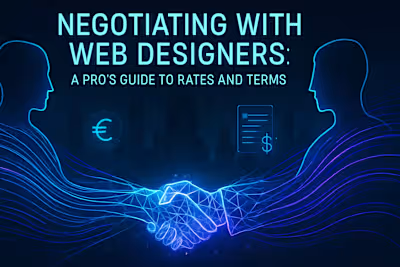Web Design Contracts 101: Essential Clauses to Protect Your Project

Web Design Contracts 101: Essential Clauses to Protect Your Project
The Core Components of Any Solid Contract
Parties Involved and Project Overview
Detailed Scope of Work and Deliverables
Project Timeline and Milestones
Protecting Your Interests: Key Legal Clauses
Payment Terms and Schedule
Intellectual Property (IP) Ownership
Confidentiality
Termination Clause
Ensuring a Smooth Workflow: Process-Related Clauses
Revisions and Feedback Process
Client Responsibilities
Communication Expectations
References
Web Design Contracts 101: Essential Clauses to Protect Your Project
A handshake isn't enough when it comes to a web design project. A clear, comprehensive contract is the foundation of a successful partnership, protecting both you and the designer. It prevents misunderstandings and provides a clear roadmap for the project. This guide covers the essential clauses every web design contract should include.
This step follows the negotiation process where you finalize the terms. Next, you should understand how to set up a fair payment schedule before you pay your designer. Whether you're looking to hire web designers for the first time or you're a seasoned pro, having a solid contract is non-negotiable.
The Core Components of Any Solid Contract
Think of your web design contract as the blueprint for your entire project. Just like you wouldn't build a house without detailed plans, you shouldn't start a web design project without a comprehensive agreement. This section breaks down the fundamental elements that form the backbone of a reliable web design agreement.
Parties Involved and Project Overview
Start with the basics. Your contract needs to clearly identify who's who in this partnership. Include the full legal names and addresses of both the client (that's you) and the designer or design agency. Don't just write "John's Web Design" – use the official business name as registered.
After identifying the parties, provide a brief but clear summary of the project. This doesn't need to be a novel, but it should capture the essence of what you're building. For example: "Client engages Designer to create a 10-page responsive website for an online bakery, including e-commerce functionality and blog integration."
This section might seem obvious, but you'd be surprised how many disputes arise from unclear identification. What if your designer operates under multiple business names? What if you're hiring through a third party? Getting these details right from the start saves headaches later.
Detailed Scope of Work and Deliverables
Here's where things get real. The scope of work is arguably the most critical section of your entire contract. It's your protection against the dreaded scope creep – that sneaky phenomenon where "just one more little change" turns into a completely different project.
Be specific. Really specific. Instead of writing "design a website," break it down:
Number of unique page designs (home, about, services, contact, etc.)
Specific features (contact forms, image galleries, social media integration)
Responsive design for mobile and tablet
Browser compatibility requirements
Design file formats you'll receive (PSD, Sketch, Figma files)
But here's the kicker – also clearly state what's not included. This might feel awkward, but it's crucial. Common exclusions include:
Content writing (unless specifically included)
Stock photography purchases
Third-party plugin licenses
Ongoing maintenance after launch
SEO optimization beyond basic setup
I once worked with a client who assumed their web design contract included a year of free updates. The designer assumed it meant delivery of the initial design only. That misunderstanding cost both parties time, money, and their professional relationship.
Project Timeline and Milestones
Time is money, especially in web design. Your contract should outline the key phases of the project with realistic deadlines for each. But here's a pro tip: build in some buffer time. Web projects rarely go exactly as planned.
A typical timeline might look like this:
Week 1-2: Discovery and research phase
Week 3-4: Initial design concepts and wireframes
Week 5-6: Design revisions and approval
Week 7-9: Development and testing
Week 10: Final revisions and launch preparation
Include what happens if deadlines slip. Is there a grace period? What if the delay is on your end because you didn't provide feedback on time? What if it's on the designer's end? Address these scenarios upfront.
Also, consider including "milestone markers" – specific points where both parties agree the project has reached a certain stage. This helps prevent the "we're 90% done" syndrome that somehow lasts for months.
Protecting Your Interests: Key Legal Clauses
Now we're getting into the meat and potatoes of contract protection. These clauses might feel overly formal, but they're your safety net when things go sideways. And trust me, even with the best intentions, projects can hit unexpected bumps.
Payment Terms and Schedule
Money talk might be uncomfortable, but unclear payment terms are a recipe for disaster. Your contract should spell out every financial detail in black and white.
Start with the total project cost. Is it a fixed fee or hourly rate? If hourly, what's the estimated total and maximum cap? Then break down the payment schedule. Common structures include:
50/50 split: Half upfront, half on completion
Three-part split: 33% to start, 33% at midpoint, 34% on delivery
Milestone-based: Payments tied to specific deliverables
Specify accepted payment methods. Bank transfer? PayPal? Credit card? Each has different fees and processing times. Also include payment deadlines. Net 30? Due on receipt? And here's something many forget – late payment penalties. A simple "1.5% monthly interest on overdue balances" can motivate timely payments.
Real-world example: A designer friend once spent three months chasing a final payment because the contract didn't specify when it was due. The client assumed they had 90 days to pay. The designer expected payment on delivery. That's three months of awkward emails that could have been avoided.
Intellectual Property (IP) Ownership
This clause can make or break your project. Who owns what, and when? The standard approach is that upon final payment, all rights to the final design transfer to you, the client. But it's not always that simple.
Consider these scenarios:
What if the designer uses stock photos or fonts with specific licenses?
Can the designer showcase the work in their portfolio?
Who owns the rejected concepts?
What about the source files and raw materials?
A well-crafted IP clause might read: "Upon receipt of final payment, Client shall own all rights, title, and interest in the final deliverables. Designer retains the right to display the work in their portfolio and marketing materials. Any third-party assets remain subject to their original licenses."
Don't forget about work created during the project but not used in the final design. Some designers retain rights to rejected concepts. Others transfer everything. There's no right answer, but there should be a clear answer in your contract.
Confidentiality
You're probably sharing sensitive information with your designer. Business strategies, customer data, financial information, upcoming product launches – all of this needs protection. A solid confidentiality or non-disclosure agreement (NDA) clause is your shield.
The clause should cover:
What information is considered confidential
How long the confidentiality obligation lasts (often 2-5 years)
Exceptions (information already public, independently developed, etc.)
Consequences of breach
Be reasonable here. Designers talk to each other and share general experiences. Your NDA shouldn't prevent them from saying they worked on a website for a bakery. But it should prevent them from sharing your secret recipe for chocolate chip cookies or your customer email list.
Termination Clause
Nobody enters a contract expecting it to fail, but sometimes partnerships just don't work out. A clear termination clause is like a prenup for your web design project – hopefully unnecessary, but invaluable if needed.
Address these key points:
Valid reasons for termination (missed deadlines, non-payment, poor quality work)
Notice period required (typically 7-14 days written notice)
What happens to work completed so far
Payment for work done up to termination
Transfer of files and materials
For example: "Either party may terminate this agreement with 10 days written notice. Upon termination, Designer shall be paid for all work completed to date, and shall deliver all work product in its current state to Client within 5 business days."
Consider including a "kill fee" clause. If you decide to cancel the project for reasons unrelated to the designer's performance, they still get compensated for their time and opportunity cost.
Ensuring a Smooth Workflow: Process-Related Clauses
The best contracts don't just protect you legally – they also set up systems for smooth collaboration. These process-related clauses might seem less critical than the legal stuff, but they're often what makes the difference between a dream project and a nightmare.
Revisions and Feedback Process
Here's a truth bomb: unlimited revisions don't exist. Well, they do, but they'll either bankrupt your designer or result in rushed, resentful work. Your contract needs to specify exactly how many rounds of revisions are included in the price.
A typical structure might be:
Initial concept: 2-3 design directions
Chosen concept: 2 rounds of major revisions
Final design: 1 round of minor tweaks
But what counts as a revision? Changing a button color is different from redesigning the entire homepage. Define the difference between minor tweaks and major changes. Some contracts use time limits ("up to 2 hours of revision time per round") while others list specific examples.
Also outline the feedback process. How should feedback be delivered? Email? Project management tool? Marked-up PDFs? Consolidated feedback prevents the chaos of conflicting opinions from different stakeholders arriving at different times.
Pro tip: Include a "feedback deadline" clause. If you don't provide feedback within, say, 5 business days, the project timeline automatically extends. This prevents designers from being blamed for delays caused by slow client response.
Client Responsibilities
Your web designer isn't a mind reader. They need stuff from you to do their job well. This section lists your homework assignments and deadlines. Common client responsibilities include:
Content provision: All text, images, and videos needed for the site. Specify formats and deadlines. "Client will provide all page copy in Word format by [date]" beats "Client will provide content" every time.
Access and credentials: Domain registrar login, hosting account details, brand guidelines, existing analytics access. Create a checklist and timeline for providing these.
Feedback and approvals: Timely responses to keep the project moving. Specify who has final approval authority to avoid the "let me check with my partner" delays.
Third-party coordination: If you're integrating with other services (payment processors, email marketing, CRM), you're usually responsible for setting up those accounts and providing API keys.
Here's what happens without this clause: The designer blocks out time for your project. You don't provide the content. They can't proceed. They take on other work. You finally send the content. Now they're booked. Your project delays, and somehow it's their fault?
Communication Expectations
Good communication can save a struggling project. Bad communication can tank a great one. Set expectations upfront about how you'll stay in touch.
Primary contacts: Designate one person from each side as the main point of contact. This prevents the "too many cooks" syndrome and conflicting directions.
Response times: What's reasonable? 24 hours for emails? Same day for urgent issues? Define "urgent" while you're at it.
Communication channels: Email for official decisions? Slack for quick questions? Weekly video calls for updates? Pick your channels and stick to them.
Meeting schedule: Regular check-ins keep projects on track. Weekly 30-minute calls during active development phases work well for most projects.
Documentation: Specify that all major decisions and changes should be documented in writing. "But you said in that phone call..." doesn't hold up well in disputes.
I've seen projects derail because the client expected instant responses to every email, while the designer checked messages once daily. Setting expectations prevents frustration on both sides.
Remember, your contract isn't just legal protection – it's a communication tool. The best contracts are clear enough that you rarely need to reference them because everyone understands their role and responsibilities.
Every web design project is unique, but these essential clauses form the foundation of a solid agreement. Take the time to get your contract right. It's easier to negotiate terms before work begins than to sort out misunderstandings halfway through your project.
The goal isn't to plan for failure – it's to create such clear expectations that success becomes the natural outcome. With a comprehensive contract in place, you can focus on what really matters: creating an amazing website that serves your business goals.
References
Like this project
Posted Jun 30, 2025
A solid web design contract is crucial. Learn about the must-have clauses, from scope and payment terms to intellectual property rights, to ensure your project is protected.











